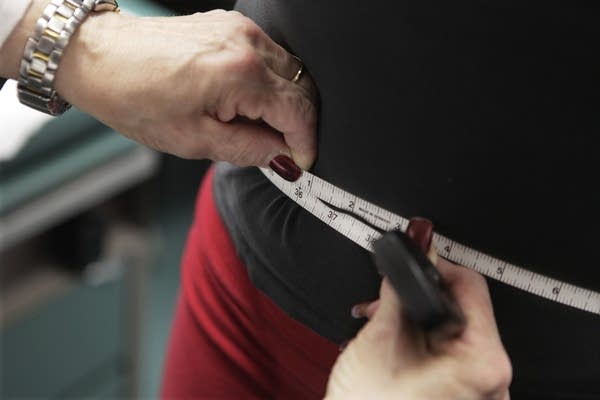Advocates: 39 states' obesity rates to pass 50 pct.
Go Deeper.
Create an account or log in to save stories.
Like this?
Thanks for liking this story! We have added it to a list of your favorite stories.

By MIKE STOBBE, AP Medical Writer
NEW YORK (AP) — A group campaigning against obesity predicts that by 2030 more than half the people in 39 states will be obese - not merely overweight, but obese.
Mississippi is expected to retain its crown as the fattest state in the nation for at least two more decades. The report predicts 67 percent of that state's adults will be obese by 2030; that would be an astounding increase from Mississippi's current 35 percent obesity rate.
The new projections were released Tuesday by Trust for America's Health and the Robert Wood Johnson Foundation. The two organizations regularly report on obesity to raise awareness, and they rely on government figures.
Turn Up Your Support
MPR News helps you turn down the noise and build shared understanding. Turn up your support for this public resource and keep trusted journalism accessible to all.
But in this case, their dismal forecast goes beyond the 42 percent national obesity level that federal health officials project by 2030. About two-thirds of Americans are overweight now. That includes those who are obese, a group that accounts for about 36 percent. Obesity rates have been holding steady in recent years.
Trust for America's Health officials said their projections are based in part on state-by-state surveys by the Centers for Disease Control and Prevention from 1999 through 2010. Those numbers come from what residents say are their height and weight when asked by interviewers over the phone. People aren't always so accurate about that.
The researchers then looked at other national data in which residents were actually weighed and measured and they made adjustments for how much people in each state might fudge the truth about their weight. They also tried to apply recent trends in obesity rates, along with other factors, to make the predictions.
Officials with Trust for America's Health said they believe their projections are reasonable.
But their outlook suggests that even in the thinnest state - Colorado, where about one-fifth of residents are obese - 45 percent are predicted to be obese by 2030. That means that every state would have an obesity rate higher than 44 percent.
Perhaps more surprising - Delaware is expected to have obesity levels nearly as high as Mississippi. Delaware currently is in the middle of the pack when it comes to self-reported obesity rates.
The report didn't detail why some states' rates were expected to jump more than others. It also didn't calculate an average adult obesity rate for the entire nation in 2030, as the CDC did a few months ago when it predicted 42 percent overall. But a researcher who worked on the Trust for America's Health study acknowledged that report's numbers point toward a figure close to 50 percent.
CDC officials declined to comment on the new report.
Whichever estimates you trust most, it's clear that the nation's weight problem is going to continue, escalating the number of cases of diabetes, heart disease and stroke, said Jeff Levi, executive director of Trust for America's Health.
By 2030, medical costs from treating obesity-related diseases are likely to increase by $48 billion, to $66 billion per year, his report said.
The focus of so much of the ongoing debate about health care is over controlling costs, Levi said. "... We can only achieve it by addressing obesity. Otherwise, we're just tinkering around the margins."
---
Listed are 2011 obesity levels followed by the Trust for America's Health projections for 2030:
• Mississippi, 35 percent, 67 percent
• Oklahoma, 31 percent, 66 percent
• Delaware, 29 percent, 65 percent
• Tennessee, 29 percent, 63 percent
• South Carolina, 31 percent, 63 percent
• Alabama, 32 percent, 63 percent
• Kansas, 30 percent, 62 percent
• Louisiana, 33 percent, 62 percent
• Missouri, 30 percent, 62 percent
• Arkansas, 31 percent, 61 percent
• South Dakota, 28 percent, 60 percent
• West Virginia, 32 percent, 60 percent
• Kentucky, 30 percent, 60 percent
• Ohio, 30 percent, 60 percent
• Michigan, 31 percent, 59 percent
• Arizona, 25 percent, 59 percent
• Maryland, 28 percent, 59 percent
• Florida, 27 percent, 59 percent
• North Carolina, 29 percent, 58 percent
• New Hampshire, 26 percent, 58 percent
• Texas, 30 percent, 57 percent
• North Dakota, 28 percent, 57 percent
• Nebraska, 28 percent, 57 percent
• Pennsylvania, 29 percent, 57 percent
• Wyoming, 25 percent, 57 percent
• Wisconsin, 28 percent, 56 percent
• Indiana, 31 percent, 56 percent
• Washington, 27 percent, 56 percent
• Maine, 28 percent, 55 percent
• Minnesota, 26 percent, 55 percent
• Iowa, 29 percent, 54 percent
• New Mexico, 26 percent, 54 percent
• Rhode Island, 25 percent, 54 percent
• Illinois, 27 percent, 54 percent
• Georgia, 28 percent, 54 percent
• Montana, 25 percent, 54 percent
• Idaho, 27 percent, 53 percent
• Hawaii, 22 percent, 52 percent
• New York, 25 percent, 51 percent
• Virginia, 29 percent, 50 percent
• Nevada, 25 percent, 50 percent
• Oregon, 27 percent, 49 percent
• Massachusetts, 23 percent, 49 percent
• New Jersey, 24 percent, 49 percent
• Vermont, 25 percent, 48 percent
• California, 24 percent, 47 percent
• Connecticut, 25 percent, 47 percent
• Utah, 24 percent, 46 percent
• Alaska, 27 percent, 46 percent
• Colorado, 21 percent, 45 percent
• District of Columbia, 24 percent, 33 percent



